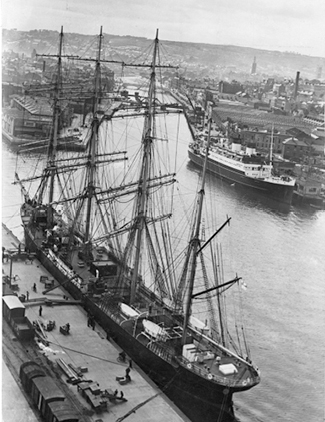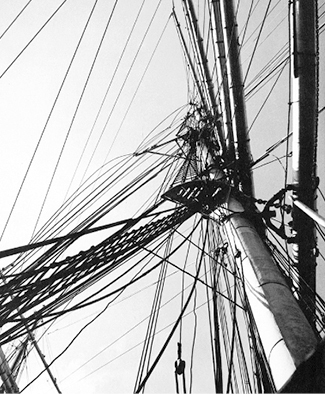
Полная версия
The Last Grain Race
The demand for caribou bags had slumped since the Gold Rush of 98. I learned this after visiting the showrooms of half a dozen manufacturers of camping equipment. In most of them I was met with blank stares of incomprehension. True to type, the assistants in those of the better sort, being asked for something outside their experience, refused to admit the existence of such a bag. In the most elegant of Piccadilly outfitters I was told by a man in a tail coat who looked like an aloof penguin that he had not been made aware of the caribou, and I returned home feeling like a character in an undiscovered sequel to Alice Through the Looking-glass.
Mr Mountstewart suggested the Army and Navy Stores. I was naturally a little wary of him by this time, but he produced that most remarkable work, the Stores Catalogue, which was as thick as a telephone directory, and this, although it did not list caribou skin bags, hinted that even more extraordinary articles could be obtained to order. I therefore decided to pay a visit to Victoria Street.
The man in the department which dealt with camping equipment received my request very well. He had heard of the caribou and could see no reason why its skin should not be turned into a sleeping-bag.
‘I suppose we could get one,’ he remarked rather gloomily. ‘It’ll have to come from one of the Hudson’s Bay posts. We’ll have to barter for it but I’ll take your name and address and let you know.’
‘When will it be here?’ I asked anxiously; time was getting short.
‘It should be here in two years. They’re nasty things. The last one gave the man who slept in it anthrax.’
I thanked him and after looking up ‘Anthrax’ in an encyclopaedia in the book department, I gave up the struggle. I was content. I knew now that if I really wanted a caribou skin bag I could have one. Instead I bought from him a real camel-hair sleeping-bag of four thicknesses made by Jaeger. In 1956 the hair of the camel is as rare as the skin of the caribou and much more expensive. I used it until 1942, when an athletic Egyptian leapt into the back of the truck in which we were driving down from the Desert, and removed three large bedding rolls belonging to myself and two brother officers; mine contained, in addition to all my other possessions, the sleeping-bag.
When I returned home, I found a letter from the owner’s agents telling me to join the sailing vessel Moshulu in Belfast. She was the one ship I had never heard of, and none of the more popular works on sailing ships gave any information about her. Even Mr Mountstewart knew nothing. However, just before I left for Euston he telephoned me. ‘I understand,’ he boomed, ‘that she is extremely large.’
4
Op the Rigging
I crossed on the night steamer from Heysham and as we came into Belfast in the cold early morning I saw for the first time the masts and spars of Moshulu. By comparison the scaffolding of the shipyards, where riveting hammers reverberated about the dark bulk of a new Union Castle liner, seemed solid and rooted in the earth. The barque was invisible, but the four enormously tall masts, fore, main and mizzen, and the less lofty jigger mast, towered into the sky above the sheds of the dockside, not white as I had imagined them, but yellow in the October sunshine.
‘Anyone’s welcome to that,’ said the smooth young steward as he plonked a pot of Oxford marmalade on my table. ‘Nasty great thing.’
I did not have the strength to argue with him. All through breakfast I had felt like someone in a condemned cell and my knees had been knocking together under the influence of a nervous impulse which I had been unable to control.
On the quay when I landed there had been some competition among the waiting taximen for my Vuitton trunk. ‘You’ll be wanting the Grand Central Hotel, most likely?’ said the shaggy owner of the most dilapidated taxi who had finally secured me as a fare. I told him I wanted to go to the Moshulu and as this did not seem to mean anything to him, I pointed to the towering masts, upon which he mumbled something about ‘that big sailer full of Chinks’ and we set off at a crazy speed, lurching into the puddles where the cobbles had subsided and slewing dangerously across the tracks of tank engines that bore down upon us at full steam. I barely noticed these things as I was in terror at the thought of climbing those masts which had a beautiful cold remoteness about them like the North Col on Everest. For the first time in my life I wished that a taxi ride would never end, but it was only three or four hundred yards to where the ship was discharging her cargo in York Dock and, too soon for me, we drew up alongside her. There was no sign of life aboard except on the well deck forward, where some stevedores were still unloading her cargo of grain.

Moshulu taken in Cork (Cobh), June 1936
I left the taximan extracting my trunk from the fore part of his vehicle where it had become jammed between the floor and the roof, and went forward to explore, waiting for a lull in the unloading operations to go up a slippery plank which led over the bulwarks and so on to the deck. When I reached it I began to feel that the taximan might be right about the ship being full of Chinese, for I found myself face to face with a rather squat, flatnosed boy of about seventeen who would have looked more at home outside a nomad tent in Central Asia. From beneath a great shock of disordered hair his eyes stared unwaveringly at me. Only the filthy dungarees in which he was dressed and the oilcan he carried proclaimed him to be a child of the West.
It was his face that finally reassured me. Surely, I thought to myself, such an ugly face has something better behind it. I held out my hand and said: ‘I am Newby, a new apprentice.’
The slant eyes looked at me suspiciously but I thought I could detect a glimmer of interest in them. He did not take my hand but a deep voice finally said, in a way that made me jump, ‘Doonkey.’ Believing this to be an epithet directed at me, I began to prepare myself for a fight. None of the books I had read said anything about a situation like this. Their heroes fought only after months of insult. Fortunately I was mistaken and he put me at ease by pointing at himself and saying: ‘Jansson, “Doonkey,” orlright,’ and at the same time grasping my hand which completely disappeared in his.
This was one of the two Donkeymen responsible for the proper functioning of the donkey engine, the diesel, brace and halliard winches and all things mechanical on board. In spite of his villainous appearance he was really the most tolerant and long-suffering of people, and we went through the entire voyage without trouble.
I indicated the trunk on the dock, and Jansson said: ‘Orlright’ again, and we went down the gangplank to the taxi. The driver was waving a piece of the roof of his vehicle which had broken off in his efforts to dislodge the trunk and was telling a little knot of stevedores everything he knew about me. As our acquaintance had been short he was drawing effortlessly on his own ample imagination. I was anxious to be rid of him and overpaid him considerably, but this encouraged him to ask for a large sum for the damage to his taxi, for which he said I was responsible. The stevedores closed in to support their countryman, but Jansson made such a threatening gesture with his tattooed forearm that they dispersed and the driver, finding himself outnumbered, gave up the struggle and drove away.
We now lifted the trunk and tried to make our way up the plank, but it was steep and my leather-soled shoes slipped backwards. ‘Orlright,’ said Jansson. He spat on his hands, slung the trunk on his back and shot up the incline like a mountain goat depositing it with a great crash on the deck. I followed him. My luggage and I were aboard.
We were now on the starboard side of the foredeck by the square opening of No 2 hatch. A travelling crane was dipping over it like a long-legged bird, pecking up great beakfuls of sacks. Underfoot was a slush of oil and grain; the oil came from a diesel winch which lay about the deck completely dismembered.
‘Kom,’ said Jansson and kicked open a door. I followed him through it and found myself in the starboard fo’c’sle. I had imagined the ship to be deserted but once I was accustomed to the half light and the thick pall of cigarette smoke that hung between the deck and the low ceiling, I was able to make out the figures of half a dozen men in overalls who were silently regarding me whilst sitting at a long table which ran the whole length of the fo’c’sle. Most of them seemed to be between seventeen and twenty years of age; all were muscular and pallid.
‘Good morning,’ I said, and their silent impassive staring went on until, like a long-awaited echo, they rumbled some kind of reply. Fortunately Jansson handed me a mug of coffee which he poured from a big white enamel jug. Someone else on the other side of the table shoved over a can of milk, a loaf of bread and a ten-pound tin of margarine. I helped myself to my second breakfast; there were some perfunctory introductions, and munching steadily, I listened to them discussing (without visible enthusiasm) my English nationality. At the same time I was able to take note of my surroundings. They were not inviting.
The fo’c’sle was about twenty feet long and thirteen feet-wide; its steel bulkheads were painted light grey; round the four sides were bunks which looked like double-banked coffins in an Italian cemetery. The lower ones mostly had home-made curtains which could be drawn when the owner was inside. Only one of the bunks was now occupied, but the curtains were half open, revealing an inert figure with its face to the wall, from which groans escaped at intervals. Down the centre of the fo’c’sle was the long narrow table, its feet screwed to the deck, the top pitted by the scrubbing and scouring of several generations of sailors. Around the edge was a raised beading, or fiddle, intended to stop the crockery sliding off in heavy weather. On either side of the table were heavy wooden benches cleated down to the deck.
Some natural illumination came from the portholes in the ship’s side, one or two of which looked out on to the well-deck; but the light was more or less obscured by a chaos of wooden sea-chests, oilskins and mysterious roped bundles which completely filled the upper bunks. Above my head was a teak skylight with a number of thick glasses set in it through which daylight seeped reluctantly. Artificial light was provided by a heavy lantern swinging perilously low above the centre of the table. Behind me was a cupboard with a shelf for crockery, and another for bread, margarine and condensed milk. Below the cupboard was a white drinking-water tank with a brass tap. The crew had just finished breakfast; on the table were the remains of this ghastly repast: some sort of thick brown stew with macaroni, now rapidly congealing, and what seemed to me, judging by the mounds of skins, an unhealthy quantity of potatoes. Standing among the ruins was an archaic gramophone with a fluted horn. This was now wound up and amidst sighs of anticipation a record was put on. There followed a preparatory churning as the needle engaged itself in the grooves and then the most appalling dissonance of sounds burst upon my ears. After I had become used to the din, I distinguished the words:
There’s a little Dutch mill on a little Dutch hill
Where the little Dutch stars shine bright.
Now a little Dutch boy and his little Dutch girl
Fell in love by the light of the moon one night …1
This was Moshulu’s only record and though I may probably never hear it again, it will always remind me of Belfast and the time after Munich.
The playing of the record released any inhibitions my arrival had imposed on the company. Conversation became animated and deafening, and as the song ground itself to a standstill the boy sitting next to me, a Lithuanian whose name I later discovered was Vytautas Bagdanavicius, turned to me, flashed a brilliant smile and said happily ‘No good’ as he wound the motor and started the record again.
Jansson, wishing to show off every item of interest, pointed at the body in the bunk and winked significantly.
‘Is he sick?’ I asked.
‘Bloddy sick, drank too much Akvavit last night,’ said Jansson. To confirm this he began prodding the blankets and when this had no effect started to roll whoever it was backwards and forwards like a piece of dough on a pastry-board, roaring ‘Rise op, rise op.’ Upon this there was a violent heaving among the blankets.
‘Perkele, perkele, perkele; devils, devils, devils,’ screamed a furious voice from the bed, mounting to a crescendo like an engine on a bench being tested to destruction. Even the hardened audience jibbed at the rich descriptive obscenity which followed and begged Jansson to leave him alone. He did so, and just like an engine, the voice died away.
Somewhere on the deck, a whistle blew. One by one the occupants of the starboard fo’c’sle went out to continue their work and soon the sounds of hammering proceeded from the port side of the ship where most of them were over the side chipping rust and painting.
Because Vytautas, the Lithuanian, had been watchman all night, he did not go with them. He advised me to get into my working clothes and report my arrival to the Mate. First he helped me stow my trunk in a convenient space behind the fo’c’sle door. Gingerly I put on my navy blue dungarees which seemed stiff and unprofessional compared with the faded blue overalls worn by most of the boys.
‘Do not leave anything in the fo’c’sle,’ said Vytautas in his rather oriental sing-song. ‘These stevedores are thieves. At sea we are all right. Here … nobody is good.’
I asked him whether he had just joined the ship, but he replied that this would be his second voyage. Moshulu had been on the timber run from Finland to Lourenço Marques in Portuguese East Africa in 1937 before going to Australia for her grain cargo. I was glad; at least he was not leaving, as many of the others were. I had already begun to cling to any acquaintance as a drowning man clutches a straw.
It so happened that I met not the First Mate but the Second, as everything was in a state of flux: some members of the crew were signing off and returning to Mariehamn, others arriving to take their place. The old Captain, Boman, who had commanded her since she joined the Erikson fleet, was going home and being replaced by Captain Sjögren who was coming from the Archibald Russell.
The Second Mate was thin, watery-eyed and bad-tempered. At sea he was to prove much better than he looked to me this morning. He did not like ports and he did not like to see the ship in her present state. My arrival did not seem propitious and after dressing me down for not reporting aft directly I had come on board, he suddenly shot at me: ‘Ever been aloft before?’
‘No, sir.’
We were standing amidships by the mainmast. He pointed to the lower main shrouds which supported the mast and said simply: ‘Op you go then.’ I could scarcely believe my ears, I had imagined that I should be allowed at least a day or two to become used to the ship and the feel of things, but this was my introduction to discipline. I looked at the Mate. He had a nasty glint in his eye and I decided I was more afraid of him than of the rigging. If I was killed it would be his fault, not mine, I said to myself with little satisfaction. Nevertheless I asked him if I could change my shoes which had slippery soles.

High rigging
‘Change your shoes? Op the rigging.’ He was becoming impatient.
At this time Moshulu was the greatest sailing ship in commission, and probably the tallest. Her main mast cap was 198 feet above the keel. I started towards the main rigging on the starboard side nearest the quay but was brought back by a cry from the Mate.
‘Babord, port side. If you fall you may fall in the dock. When we’re at sea you will always use the weather rigging, that’s the side from which the wind blows. Never the lee rigging. And when I give you an order you repeat it.’
‘Op the rigging,’ I said.
The first part of the climb seemed easy enough. The lower main shrouds supporting the mast were of heavy wire made from plough steel and the first five ratlines were iron bars seized across four shrouds to make a kind of ladder which several men could climb at once. Above them the ratlines were wooden bars seized to the two centre shrouds only, the space for the feet becoming narrower as they converged at the ‘top’, eighty feet up, where it was difficult to insert a foot as large as mine in the ratlines at all. Before reaching this point, however, I came abreast of the main yard. It was of tapered steel, ninety-five and a half feet from arm to arm, two and a half feet in diameter at the centre and weighed over five tons. It was trussed to the mainmast by an iron axle and preventer chain which allowed it to be swung horizontally from side to side by means of tackle to the yardarms; an operation known as ‘bracing’.
Above me was the ‘top’, a roughly semi-circular platform with gratings in it. This was braced to the mast by steel struts called futtock shrouds. To get to the ‘top’ I had to climb outwards on the rope ratlines seized to the futtock shrouds. There was a hole in the ‘top’ which it was considered unsporting to use. I only did so once for the experience and cut my ear badly on a sharp projection which was probably put there as a deterrent. I found difficulty in reaching the top this first time and remained transfixed, my back nearly parallel with the deck below, whilst I felt for a rope ratline with one foot. I found it at last and heaved myself, nearly sick with apprehension, on to the platform, where I stood for a moment, my heart thumping. There was only a moment’s respite, in which I noticed that the mainmast and the topmast were in one piece – not doubled as in most sailing ships – before the dreadful voice of the Mate came rasping up at me:
‘Get on op.’
The next part was nearly fifty feet of rope ratlines seized to the topmast shrouds. Almost vertical, they swayed violently as I went aloft; many of them were rotten and one broke underfoot when I was at the level of the topsail yards. Again the voice from the deck:
‘If you want to live, hold on to those shrouds and leave the bloody ratlines alone.’
The lower topsail yard was slung from an iron crane but the upper topsail yard above it was attached to a track on the foreside of the topmast allowing the yard to be raided by means of a halliard more than twenty-five feet almost to the level of the crosstrees. The crosstrees formed an open frame of steel girdering about 130 feet up, at the heel of the topgallant mast. Originally the topsail had been a single sail, but to make it easier for the reduced crews to take in sail, it had been divided into two. At the moment the upper topsail yard was in its lowered position, immediately on top of the lower topsail yard. The crosstrees seemed flimsy when I reached them; two long arms extended aft from the triangle, spreading the backstays of the royal mast, the highest mast of all. I stood gingerly on this slippery construction; the soles of my shoes were like glass; all Belfast spread out below. I looked between my legs down to a deck as thin as a ruler and nearly fell from sheer funk.
‘Op to the royal yard,’ came the imperious voice, fainter now. Another forty feet or so of trembling topgallant shroud, past the lower and upper topgallant yards, the upper one, like the upper topsail yard, movable on its greased track. The ratlines were very narrow now and ceased altogether just below the level of the royal yard.
I was pretty well all in emotionally and physically but the by now expected cry of ‘Out on the yard’ helped me to heave myself on to it. In doing so I covered myself with grease from the mast track on which the royal yard moved up and down. It was fifty feet long and thinner than those below it. As on all the other yards, an iron rail ran along the top. This was the jackstay, to which the sail was bent. (In cadet training ships this rail would have had another parallel to hold on to, as, with the sail bent to the forward jackstay, there was little or no handhold. Moshulu had not been built for cadets and this refinement was lacking. With no sails bent what I had to do was easy, but I did not appreciate my good fortune at the time.) Underneath the yard was a wire rope which extended the length of it and was supported half-way between the mast and either yard-arm by vertical stirrups. This footrope was called the ‘horse’ and when I ventured out on it I found it slippery as well as slack so that both feet skidded in opposite directions, leaving me like a dancer about to do the splits, hanging on grimly to the jackstay.
‘Out. Right out to the yardarm,’ came the Mate’s voice, fainted still. I hated him at this moment. There were none of the ‘joosts’ and ‘ploddys’ of the stylised Scandinavian to make me feel superior to this grim officer. He spoke excellent English.
Somehow I reached the yardarm. I tried to rest my stomach on it, and stick my legs out behind me but I was too tall; the foot-rope came very close up to the yard at this point, where it was shackled to the brace pendant, and my knees reached to the place on the yard where the riggers had intended my stomach to be, so that I had the sensation of pitching headlong over it. Fortunately there was a lift shackled to the yardarm band, a wire tackle which supported the yard in its lowered position, and to this I clung whilst I looked about me.
What I saw was very impressive and disagreeable. By now I had forgotten what the Mate had said about falling into the dock and I was right out at the starboard yardarm, 160 feet above the sheds into which Moshulu’s 62,000 sacks of grain were being unloaded. The rooftops of these sheds were glass and I remember wondering what would happen if I fell. Would I avoid being cut to pieces by the maze of wires below, or miss them and make either a large expensive crater in the roof or a smaller one shaped like me? I also wondered what kind of technique the ambulance men employed to scoop up what was left of people who fell from such heights. I tried to dismiss these melancholy thoughts but the beetle-like figures on the dock below that were stevedores only accentuated my remoteness. The distant prospect was more supportable: a tremendous panorama beyond the city to the Antrim Hills and far up the Lough to the sea.
‘Orlright,’ called the Mate. ‘Come in to the mast.’ I did so with alacrity, but was not pleased when he told me to go to the truck on the very top of the mast. I knew that with these blasted shoes I could never climb the bare pole, so I took them off, and my socks too, and wedged them under the jackstay.
There were two or three very rotten ratlines seized across the royal backstays. The lowest broke under my weight so I used the backstays alone to climb up to the level of the royal halliard sheave to which the yard was raised when sail was set. Above this was nothing. Only six feet of bare pole to the truck. I was past caring whether I fell or not.
I embraced the royal mast and shinned up. The wind blew my hair over my nose and made me want to sneeze. I stretched out my arm and grasped the round hardwood cap 198 feet above the keel and was surprised to find it was not loose or full of chocolate creams as a prize. Now the bloody man below me was telling me to sit on it, but I ignored him. I could think of no emergency that would make it necessary. So I slid down to the royal halliard and to the yard again.
‘You can come down now,’ shouted the Mate. I did. It was worse than going up and more agonising as I was barefoot, with my shoes stuffed inside my shirt.
‘You were a fool to take your shoes off,’ said the Mate when I reached the deck. ‘Now you can learn to clean the lavatories.’








